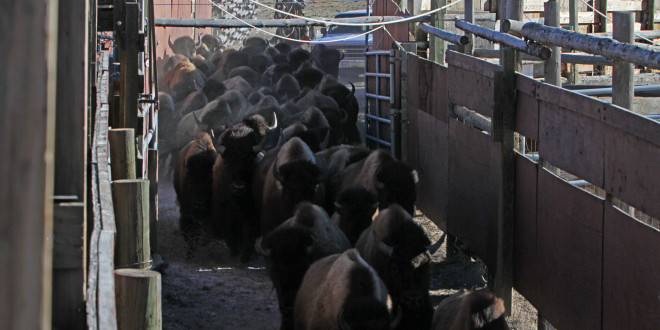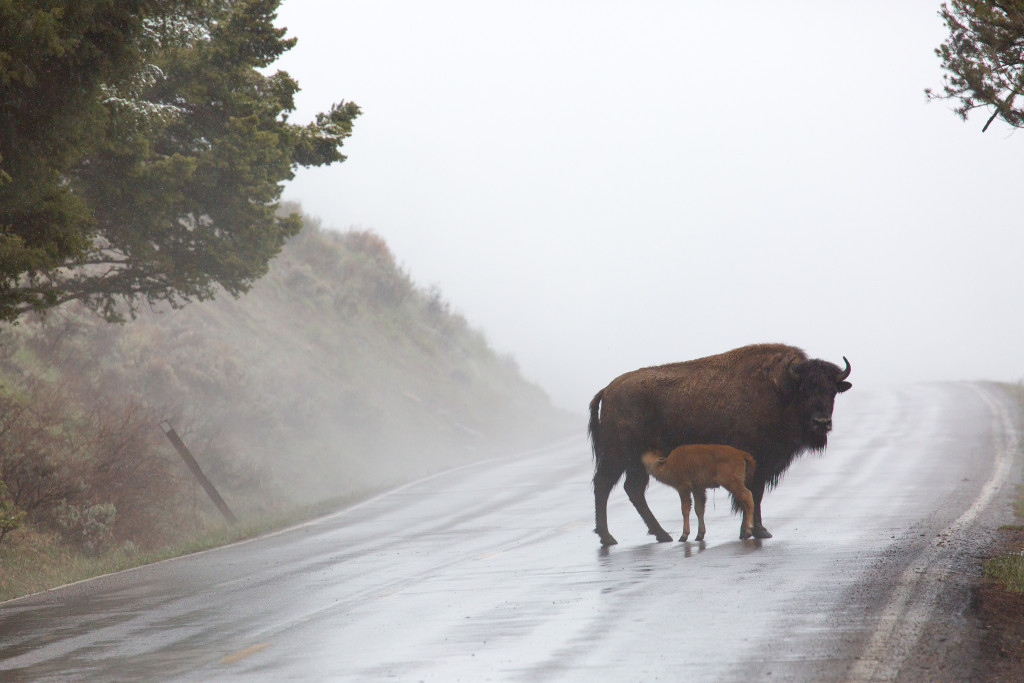Wednesday, wildlife managers said the Stephens Creek Bison Trap will need to open sooner next year, in order to capture more bison.
The suggestion comes after officials captured fewer bison than they intended to this past season. Wildlife officials also faulted how the bison-hunting season was handled this year.
We previously reported that several changes were underway in bison operations this past year. Firstly, the bison trap at Stephens Creek would open February 15, with trapping lasting until March 31. Officials hoped a shorter trapping season would give tribal hunters more time to reach their own quotas. With a limit on trapping operations, officials also decreed that hunting would be limited in the Gardiner Basin west of Yellowstone River.
All told, officials hoped to reduce the population by 600 to 900. At last count, approximately 550 bison were culled from the Yellowstone herd. According to the Bozeman Daily Chronicle, officials from the various partner agencies under the Interagency Bison Management Plan are regrouping and reassessing bison operations based on this year’s outcome:
Yellowstone biologist PJ White said Wednesday that the population saw no significant decrease last year, and is now somewhere between 4,800 and 5,200 bison.
Officials will now work on the winter operations plan that will line out any hunting rules and goals for population reduction, a document that will be final in December. Some new changes they tried out last winter are likely on their way out — like the delayed opening of the trap.
The park agreed to keep the trap closed until Feb. 15 to let hunting play a more significant role in reducing the population. A total of 384 bison were confirmed killed during the hunt last winter, the highest harvest number since the hunt was reimplemented in 2005. But most agreed that letting rangers catch bison earlier in the year wouldn’t have harmed hunting opportunity.
John Carter, a staff attorney for the Confederated Salish and Kootenai Tribes, said the delayed capture date “created a little more of an urgency” as hunters tried to take all the bison they could before the trap would open.
But that wasn’t the only change they said didn’t work. Three tribal governments and the state of Montana agreed to take time off from hunting the bison at Beattie Gulch near Gardiner — a place on the border of Yellowstone National Park brimming with controversy.
People who live there have complained in the past about the number of hunters that go there, constant gunfire and unsightly gut piles left behind after the hunters are done. Bison advocates have argued that the dynamic in that area prevents bison from distributing farther north, toward the Paradise Valley.
As a way to try to address both of those problems, the three tribal governments and the state agreed to take four days off every other week to reduce pressure. Instead, officials said, it concentrated the hunting pressure and led to congestion and more safety problems.
“At times there was just too many people and too many guns on this one small landscape at one time,” [Montana Fish, Wildlife and Parks regional supervisor Sam] Sheppard said.
Jeremy Wolf, vice chairman of the Confederated Tribes of the Umatilla Indian Reservation board of trustees, said the change forced hunters to “essentially all arrive at the same time,” which created safety issues.
With regards to hunting, the IBMP agencies are weighing several changes. For instance, they’re debating whether hunters should better signal they’re hunting—whether by waving a flag or some other measure. Officials are also debating whether to coordinate a radio frequency so state and tribal game wardens can collaborate more efficiently and keep better track of each other.
According to the Chronicle, one measure worked well, which will likely be implemented in the next bison plan: designated clean zones. Hunters were asked to take down bison at least 150 yards from the road, to alleviate problems from skinning and cleaning carcasses. Although the U.S. Forest Service’s district ranger in Gardiner told the Chronicle the practice worked “remarkably well,” there are still some kinks that need to be ironed out.
It remains to be seen what sort of changes will be made in next year’s plan. For instance, it will be the first season since Montana Governor Steve Bullock decreed bison could roam year-round in select portions of southern and southwestern Montana; previously, they were hazed back into the Park. It also remains to be seen whether the proposed quarantine program (which would house Yellowstone bison on the Fort Peck Indian Reservation in eastern Montana and screen them for brucellosis, before they’re shipped to other herds across the nation).
There’s also the matter of a pending lawsuit brought against the U.S. Fish and Wildlife Service and the Department of the Interior by a coalition of wildlife advocates to designate Yellowstone bison as a threatened or endangered species.
 Yellowstone Insider Your Complete Guide to America's First National Park
Yellowstone Insider Your Complete Guide to America's First National Park







You must be logged in to post a comment.